rfc2710 Multicast Listener Discovery (MLD) for IPv6
IPv6 MLD 简介
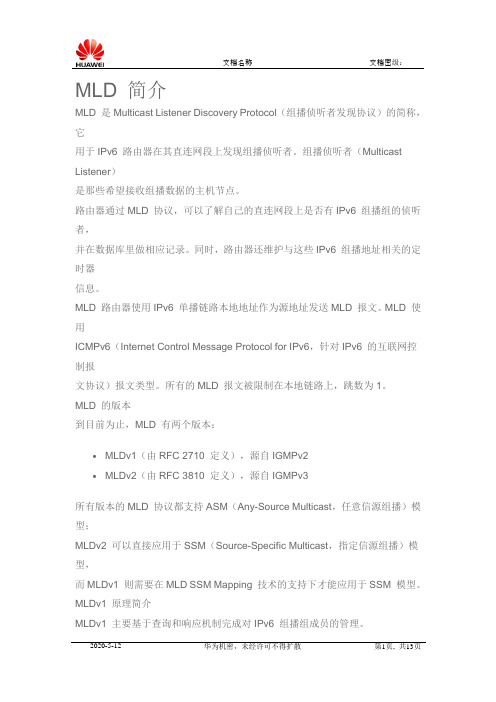
MLD 简介MLD 是Multicast Listener Discovery Protocol(组播侦听者发现协议)的简称,它用于IPv6 路由器在其直连网段上发现组播侦听者。
组播侦听者(Multicast Listener)是那些希望接收组播数据的主机节点。
路由器通过MLD 协议,可以了解自己的直连网段上是否有IPv6 组播组的侦听者,并在数据库里做相应记录。
同时,路由器还维护与这些IPv6 组播地址相关的定时器信息。
MLD 路由器使用IPv6 单播链路本地地址作为源地址发送MLD 报文。
MLD 使用ICMPv6(Internet Control Message Protocol for IPv6,针对IPv6 的互联网控制报文协议)报文类型。
所有的MLD 报文被限制在本地链路上,跳数为1。
MLD 的版本到目前为止,MLD 有两个版本:∙MLDv1(由RFC 2710 定义),源自IGMPv2∙MLDv2(由RFC 3810 定义),源自IGMPv3所有版本的MLD 协议都支持ASM(Any-Source Multicast,任意信源组播)模型;MLDv2 可以直接应用于SSM(Source-Specific Multicast,指定信源组播)模型,而MLDv1 则需要在MLD SSM Mapping 技术的支持下才能应用于SSM 模型。
MLDv1 原理简介MLDv1 主要基于查询和响应机制完成对IPv6 组播组成员的管理。
1. 查询器选举机制当一个网段内有多台IPv6 组播路由器时,由于它们都能从主机那里收到MLD 成员关系报告报文(Multicast Listener Report Message),因此只需要其中一台路由器发送MLD 查询报文(Query Message)就足够了。
这就需要有一个查询器(Querier)的选举机制来确定由哪台路由器作为MLD 查询器,其选举过程如下:(1) 所有MLD 路由器在初始时都认为自己是查询器,并向本地网段内的所有主机和路由器发送MLD 普遍组查询(General Query)报文(目的地址为FF02::1);(2) 本地网段中的其它MLD 路由器在收到该报文后,将报文的源IPv6 地址与自己的接口地址作比较。
s8500路由交换机 操作手册(V2.00)4-8 MLD配置

MLD 目录目录第1章 MLD配置....................................................................................................................1-11.1 MLD简介...........................................................................................................................1-11.1.1 MLD概述.................................................................................................................1-11.1.2 MLD的版本.............................................................................................................1-11.1.3 MLDv1原理简介......................................................................................................1-11.1.4 MLDv2原理简介......................................................................................................1-31.1.5 SSM Mapping功能..................................................................................................1-41.1.6 MLD报文类型..........................................................................................................1-41.1.7 协议规范..................................................................................................................1-71.2 MLD配置任务简介.............................................................................................................1-71.3 配置MLD基本功能............................................................................................................1-71.3.1 配置准备..................................................................................................................1-71.3.2 使能IPv6组播路由..................................................................................................1-81.3.3 使能MLD.................................................................................................................1-81.3.4 配置MLD版本.........................................................................................................1-81.3.5 配置静态加入IPv6组播组.......................................................................................1-91.3.6 配置IPv6组播组过滤器...........................................................................................1-91.4 调整MLD性能.................................................................................................................1-101.4.1 配置准备................................................................................................................1-101.4.2 配置MLD报文选项...............................................................................................1-101.4.3 配置MLD定时器...................................................................................................1-111.4.4 配置MLD快速离开...............................................................................................1-141.5 MLD显示和维护...............................................................................................................1-141.6 MLD典型配置举例...........................................................................................................1-151.7 常见配置错误举例............................................................................................................1-181.7.1 接收者侧路由器上无组成员信息............................................................................1-181.7.2 同一网段各路由器上组成员关系不一致.................................................................1-181.7.3 转发项中未包含MLD接口.....................................................................................1-19第1章 MLD配置说明:本文所涉及的路由器和路由器图标,代表了一般意义下的路由器或运行了路由协议的85系列路由交换机。
MLD测试环境搭建
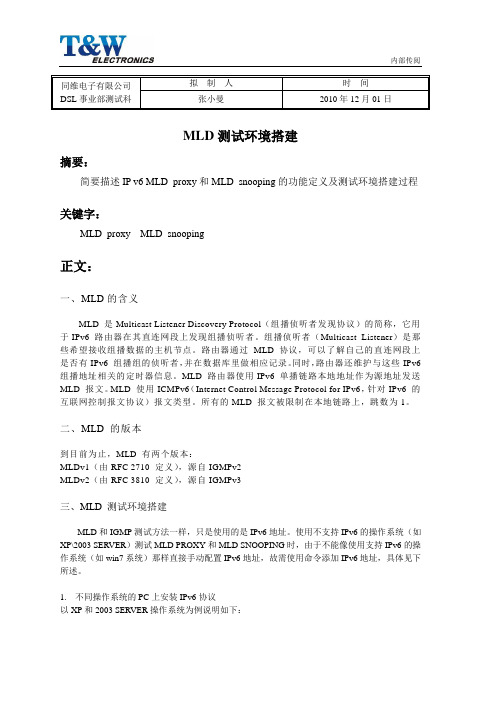
MLD测试环境搭建摘要:简要描述IP v6 MLD_proxy和MLD_snooping的功能定义及测试环境搭建过程关键字:MLD_proxy MLD_snooping正文:一、MLD的含义MLD 是Multicast Listener Discovery Protocol(组播侦听者发现协议)的简称,它用于IPv6 路由器在其直连网段上发现组播侦听者。
组播侦听者(Multicast Listener)是那些希望接收组播数据的主机节点。
路由器通过MLD 协议,可以了解自己的直连网段上是否有IPv6 组播组的侦听者,并在数据库里做相应记录。
同时,路由器还维护与这些IPv6 组播地址相关的定时器信息。
MLD 路由器使用IPv6 单播链路本地地址作为源地址发送MLD 报文。
MLD 使用ICMPv6(Internet Control Message Protocol for IPv6,针对IPv6 的互联网控制报文协议)报文类型。
所有的MLD 报文被限制在本地链路上,跳数为1。
二、MLD 的版本到目前为止,MLD 有两个版本:MLDv1(由RFC 2710 定义),源自IGMPv2MLDv2(由RFC 3810 定义),源自IGMPv3三、MLD_测试环境搭建MLD和IGMP测试方法一样,只是使用的是IPv6地址。
使用不支持IPv6的操作系统(如XP\2003 SERVER)测试MLD PROXY和MLD SNOOPING时,由于不能像使用支持IPv6的操作系统(如win7系统)那样直接手动配置IPv6地址,故需使用命令添加IPv6地址,具体见下所述。
1.不同操作系统的PC上安装IPv6协议以XP和2003 SERVER操作系统为例说明如下:Win xp PC 安装IPv6协议是在命令提示符下输入:→ipv6 installWin 2003 server PC安装IPv6协议是在命令提示符下输入:→netsh→interface→ipv6→install 具体见下图:2.MLD_proxy测试环境搭建当CPE工作在路由W AN连接下进行MLD_proxy测试时,在组播源侧需要配置IPv6地址和路由。
中移动家庭网关终端技术规范v3.0.0
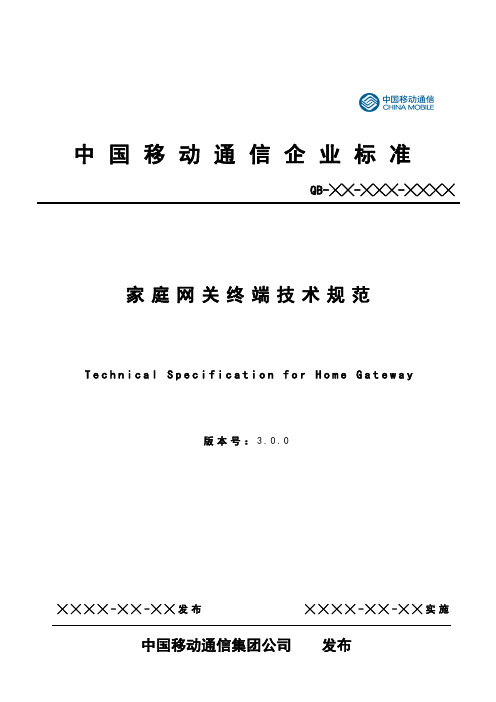
中国移动通信企业标准QB-╳╳-╳╳╳-╳╳╳╳家庭网关终端技术规范T e c h n i c a l S p e c i f i c a t i o n f o r H o m e G a t e w a y版本号:3.0.0╳╳╳╳-╳╳-╳╳发布╳╳╳╳-╳╳-╳╳实施目录1. 范围 (1)2. 规范性引用文件 (1)3. 术语、定义和缩略语 (5)4. 设备总体定义 (9)4.1.设备在网络中的位置 (9)4.2.接口定义 (10)4.3.设备类型 (10)5. 接入型家庭网关 (11)5.1.接口要求 (11)5.1.1. 网络侧接口 (11)5.1.1.1. 网络侧接口描述 (11)5.1.1.2. 网络侧以太网接口要求 (12)5.1.1.3. PON接口要求 (12)5.1.1.4. TD-SCDMA接口要求 (12)5.1.1.5. TD-LTE接口要求 (12)5.1.2. 用户侧接口 (12)5.1.2.1. 用户侧以太网接口要求 (12)5.1.2.2. WLAN接口 (12)5.1.2.3. USB接口(可选) (12)5.2.功能要求 (13)5.2.1. 数据通信要求 (13)5.2.1.1. IP协议要求 (13)5.2.1.2. 数据转发功能要求 (13)5.2.1.3. DNS功能要求 (14)5.2.1.4. IPv4地址管理及拨号管理功能要求 (14)5.2.1.5. IPv6地址管理及拨号管理功能要求 (16)5.2.1.6. IPv4 NAT要求 (16)5.2.1.7. ALG要求 (17)5.2.1.8. 组播要求 (17)5.2.1.9. 其他功能要求 (17)5.2.2. 安全要求 (17)5.2.2.1. 防火墙 (17)5.2.2.2. 登陆WEB页面的安全要求 (17)5.2.2.3. 设备安全性 (18)5.2.3. QoS 要求 (18)5.2.4. VLAN功能要求 (19)5.2.5. USB扩展及管理(可选) (19)5.2.6. 设备发现要求 (19)5.2.6.1. UPnP (19)5.2.6.2. DLNA(可选) (19)5.2.7.1. 支持WLAN的开启和禁用 (20)5.2.7.2. 基本要求 (20)5.2.7.3. 多SSID要求 (20)5.2.7.4. WLAN安全要求 (20)5.2.7.5. WLAN QoS要求 (21)5.2.7.6. WPS要求 (21)5.2.8. 基本应用要求 (22)5.2.8.1. WLAN共享 (22)5.2.8.2. 家庭存储(可选) (23)5.3.性能要求 (23)5.3.1. 路由转发性能要求 (23)5.3.1.1. 吞吐量 (23)5.3.1.2. 地址学习 (23)5.3.1.3. 缓存大小 (23)5.3.1.4. 连接数量要求 (24)5.3.2. WLAN无线性能要求 (24)5.3.2.1. WLAN吞吐量性能要求 (24)5.3.2.2. WLAN覆盖性能要求 (24)5.3.2.3. WLAN接收灵敏度要求 (24)5.4.管理和维护要求 (24)5.4.1. 本地管理和配置要求 (24)5.4.1.1. 本地管理基本要求 (24)5.4.1.2. 用户分级管理 (25)5.4.1.3. 系统信息管理 (25)5.4.1.4. 基本配置 (25)5.4.1.5. 高级配置 (26)5.4.1.6. 设备管理 (27)5.4.1.7. 网络诊断 (27)5.4.1.8. 设备认证注册功能 (27)5.4.2. 远程管理要求 (29)5.4.2.1. 远程管理基本要求 (30)5.4.2.2. 远程参数配置和性能监测 (30)5.4.2.3. 远程故障诊断功能 (30)5.4.2.4. 设备告警功能 (30)5.4.2.5. 远程链路维持功能 (31)5.4.2.6. 软件远程管理 (31)5.4.2.7. 业务部署和控制 (31)5.4.2.8. PON上行家庭网关远程管理实现方式 (31)5.4.3. 日志功能要求 (32)5.5.预配置要求 (33)5.5.1. 预配置要求 (33)5.6.硬件要求 (34)5.6.1. 基本要求 (34)5.6.3. 硬件基本框图示例 (34)5.7.软件要求 (34)5.7.1. 基本要求 (34)5.7.2. 软件基本架构 (35)5.7.3. 软件接口要求 (35)5.7.4. 用户登录要求 (36)5.7.5. 系统升级要求 (36)5.8.配置界面要求 (36)5.8.1. 配置界面要求 (36)5.8.2. 配置界面用户权限要求 (36)5.9.设备标识要求 (38)5.10.外观及附件要求 (39)5.10.1. 运营商Logo要求 (39)5.10.2. 设备标签要求 (39)5.10.3. 网关指示灯要求 (40)5.10.4. 开关与按键要求 (41)5.10.5. 设备面板标识要求 (41)5.10.6. 设备接口要求 (41)5.10.7. 附件要求 (41)5.11.运行环境要求 (42)5.11.1. 供电要求 (42)5.11.2. 环境要求 (42)5.11.3. 抗电磁干扰能力 (42)5.11.4. 设备本身产生的电磁干扰要求 (42)5.11.5. 过压过流保护 (42)5.12.认证要求 (43)6. 接入型家庭网关支持物联网功能 (43)6.1.接入型家庭网关支持宜居通的功能要求(内置433M模块) (43)6.1.1. 433M模块要求 (43)6.1.2. 外围设备要求 (43)6.1.3. 业务功能描述 (43)6.1.3.1. 安防功能要求 (44)6.1.3.2. 家电控制功能 (44)6.1.4. 接入型家庭网关配置界面要求 (45)6.1.4.1.配置界面要求 (45)6.1.4.2. 配置界面用户权限要求 (46)6.2.接入型家庭网关支持基于低功耗W I F I的物联网功能要求 (48)6.2.1. 设备接入功能要求 (48)6.2.1.1. WiFi接入 (48)6.2.1.1.1. 接入型家庭网关要求 (48)6.2.1.1.2. 外设要求 (49)6.2.1.2. DHCP流程要求 (49)7. 宽带应用型家庭网关 (49)7.1.类型描述 (49)7.2.分体机接入设备要求 (49)7.3.分体机应用设备(机顶盒)要求 (50)7.3.1. 硬件要求 (50)7.3.1.1. 硬件、接口及按键要求 (50)7.3.1.2. 遥控器要求及参考设计 (53)7.3.1.3. 电源要求 (53)7.3.1.4. 配件要求 (53)7.3.1.5. 设备标识要求 (53)7.3.2. 网络侧接口要求 (54)7.3.3. 业务功能要求 (54)7.3.3.1. 互联网电视应用 (54)7.3.3.2. 多屏互动功能 (54)7.3.3.2.1. 概述 (54)7.3.3.2.2. 镜像功能 (54)7.3.3.2.3. 分享功能 (55)7.3.3.3. 家庭高清视频通话(可选) (55)7.3.3.4. 家庭卡拉OK功能(可选) (56)7.3.3.5. 语音交互功能 (56)7.3.4. 软件要求 (56)7.3.4.1. 操作系统要求 (56)7.3.4.2. 软件协议要求 (57)7.3.4.3. 编码及解码能力要求 (57)7.3.4.3.1. 编解码能力要求 (57)7.3.4.3.2. 音视频播放质量要求 (58)7.3.4.4. 屏幕管理要求 (58)7.3.4.5. 防刷机要求 (58)7.3.5. 管理要求 (59)7.3.5.1. 操作管理 (59)7.3.5.2. 软件管理 (60)7.3.5.3. 文件管理 (60)7.3.5.4. 配置管理 (60)7.3.6. 其他要求 (61)7.3.6.1. 供电要求 (61)7.3.6.2. 环境要求 (61)7.3.6.3. 噪声要求 (62)7.4.一体机设备要求 (62)7.4.1. 网络侧接口要求 (62)7.4.2. 网络接入功能要求 (62)7.4.3. 业务功能要求 (62)7.4.4. 软件要求 (62)7.4.5. 管理要求 (62)7.4.6. 硬件要求 (62)7.4.7. 其他要求 (62)7.4.7.1. 供电要求 (62)7.4.7.2. 环境要求 (63)7.4.7.3. 噪声要求 (63)8. 编制历史 (63)附录A省公司代码 (64)附录B设备故障消息(标准性附录) (65)B.1 告警编号规则 (65)B.2 设备告警信息列表 (66)附录C WIMO协议说明 (67)C.1设备类型和功能流程 (67)C.2网络连接 (68)C.3设备连接 (69)C.4媒体格式要求 (70)C.4.1视频编解码流程 (70)C.4.2 M-JPEG视频编解码方案 (70)C.4.3 H.264视频编解码方案 (70)C.4.4 音频编解码流程 (70)附录D手机遥控接口说明 .............................................................................. 错误!未定义书签。
组播侦听发现(MLDv1)协议详解_RFC2710
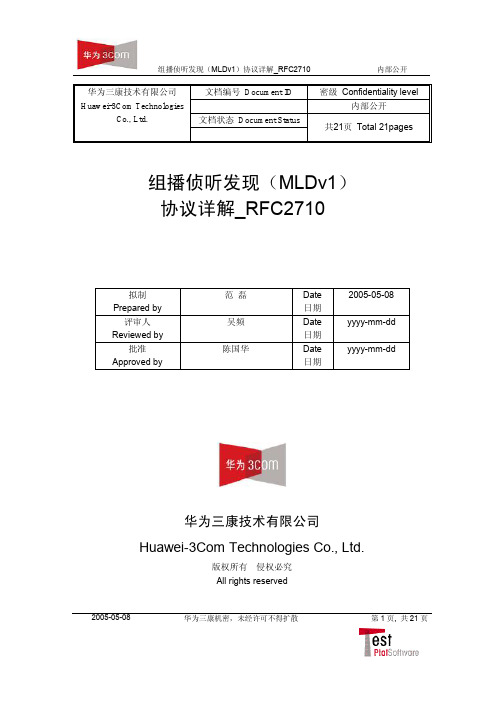
2005-05-08 华为三康机密,未经许可不得扩散 第1页, 共21页文档编号 Document ID密级 Confidentiality level内部公开 文档状态 Document Status华为三康技术有限公司 Huawei-3Com TechnologiesCo., Ltd.共21页Total 21pages组播侦听发现(MLDv1) 协议详解_RFC2710拟制Prepared by 范 磊 Date 日期 2005-05-08 评审人 Reviewed by 吴频 Date 日期 yyyy-mm-dd 批准 Approved by陈国华Date 日期yyyy-mm-dd华为三康技术有限公司Huawei-3Com Technologies Co., Ltd.版权所有 侵权必究 All rights reserved2005-05-08 华为三康机密,未经许可不得扩散 第2页, 共21页修订记录Revision record日期 Date修订版本Revision version 修改描述change Description作者 Author2005-05-08 1.00 初稿完成 initial transmittal范 磊目录Table of Contents1MLDv1简介 (5)2消息格式 (5)2.1代码(Code) (6)2.2校验和(Checksum) (7)2.3最大响应延迟(Maximum Response Delay) (7)2.4保留(Reserved) (7)2.5组播地址(Multicast Address) (7)2.6其他区域(Other fields) (7)3协议描述 (8)4节点状态转换图 (10)5路由器状态转换图 (14)6定时器及其缺省值列表 (19)6.1健壮性变量(Robustness Variable) (19)6.2查询间隔(Query Interval) (20)6.3查询响应间隔(Query Response Interval) (20)6.4组播侦听者间隔(Multicast Listener Interval) (20)6.5其他查询器存在间隔(Other Querier Present Interval) (20)6.6启动查询间隔(Startup Query Interval) (20)6.7启动查询次数(Startup Query Count) (21)6.8最后侦听者查询间隔(Last Listener Query Interval) (21)6.9最后侦听者查询次数(Last Listener Query Count) (21)6.10主动报告间隔(Unsolicited Report Interval) (21)7消息目的地址 (21)2005-05-08 华为三康机密,未经许可不得扩散第3页, 共21页2005-05-08华为三康机密,未经许可不得扩散 第4页, 共21页文档标题关键词Key words :IPv6、MLD 、IGMPv2 摘 要Abstract :本文档介绍了IPv6路由器所使用的一种协议,用以发现在其直连网络上的组播侦听者(即希望接收组播数据的节点)的存在,并且能明确发现这些邻居节点所感兴趣的组播地址。
中移动家庭网关终端技术规范v

中国移动通信企业标准 家庭网关终端技术规范版本号:3.0.0 中国移动通信集团公司 发布╳╳╳╳-╳╳-╳╳发布 ╳╳╳╳-╳╳-╳╳实施 QB-╳╳-╳╳╳-╳╳╳╳T e c h n i c a l S p e c if i c a t i o n f o r H o m e G a t e w a y目录1. 范围 ................................................................................................................................................2. 规范性引用文件 .............................................................................................................................3. 术语、定义和缩略语 .....................................................................................................................4. 设备总体定义.................................................................................................................................4.1.设备在网络中的位置 ..................................................................................................................4.2.接口定义 ......................................................................................................................................4.3.设备类型 ......................................................................................................................................5. 接入型家庭网关 .............................................................................................................................5.1.接口要求 ......................................................................................................................................网络侧接口......................................................................................................................................网络侧接口描述..........................................................................................................................................网络侧以太网接口要求..............................................................................................................................接口要求 .......................................................................................................................................................接口要求 .......................................................................................................................................................接口要求 .......................................................................................................................................................用户侧接口......................................................................................................................................用户侧以太网接口要求..............................................................................................................................接口 ...............................................................................................................................................................接口(可选)................................................................................................................................................5.2.功能要求 ......................................................................................................................................数据通信要求..................................................................................................................................协议要求 .......................................................................................................................................................数据转发功能要求......................................................................................................................................功能要求 .......................................................................................................................................................地址管理及拨号管理功能要求....................................................................................................................地址管理及拨号管理功能要求....................................................................................................................要求 ...............................................................................................................................................................要求 ...............................................................................................................................................................组播要求 .....................................................................................................................................................其他功能要求..............................................................................................................................................安全要求..........................................................................................................................................防火墙 .........................................................................................................................................................登陆WEB页面的安全要求..........................................................................................................................设备安全性 .................................................................................................................................................要求....................................................................................................................................................功能要求............................................................................................................................................扩展及管理(可选)........................................................................................................................设备发现要求.........................................................................................................................................................................................................................................................................................................(可选) .......................................................................................................................................................支持WLAN的开启和禁用............................................................................................................................基本要求 .....................................................................................................................................................多SSID要求................................................................................................................................................安全要求 .......................................................................................................................................................5要求 ............................................................................................................................................................要求 ...............................................................................................................................................................基本应用要求................................................................................................................................... WLAN共享 ..................................................................................................................................................家庭存储(可选)......................................................................................................................................5.3.性能要求 ......................................................................................................................................路由转发性能要求..........................................................................................................................吞吐量 .........................................................................................................................................................地址学习 .....................................................................................................................................................缓存大小 (23)连接数量要求.............................................................................................................................................. 无线性能要求....................................................................................................................................吞吐量性能要求 (23)覆盖性能要求................................................................................................................................................接收灵敏度要求............................................................................................................................................5.4.管理和维护要求 (24)本地管理和配置要求......................................................................................................................本地管理基本要求......................................................................................................................................用户分级管理 (24)系统信息管理..............................................................................................................................................基本配置 .....................................................................................................................................................高级配置 .....................................................................................................................................................设备管理 .....................................................................................................................................................网络诊断 .....................................................................................................................................................设备认证注册功能......................................................................................................................................远程管理要求..................................................................................................................................远程管理基本要求......................................................................................................................................远程参数配置和性能监测..........................................................................................................................远程故障诊断功能......................................................................................................................................设备告警功能..............................................................................................................................................远程链路维持功能......................................................................................................................................软件远程管理..............................................................................................................................................业务部署和控制..........................................................................................................................................上行家庭网关远程管理实现方式 ................................................................................................................日志功能要求..................................................................................................................................5.5.预配置要求 ..................................................................................................................................预配置要求......................................................................................................................................5.6.硬件要求 ......................................................................................................................................基本要求..........................................................................................................................................硬件基本框图示例..........................................................................................................................5.7.软件要求 ......................................................................................................................................基本要求..........................................................................................................................................软件基本架构................................................................................................. 错误!未定义书签。
MLD
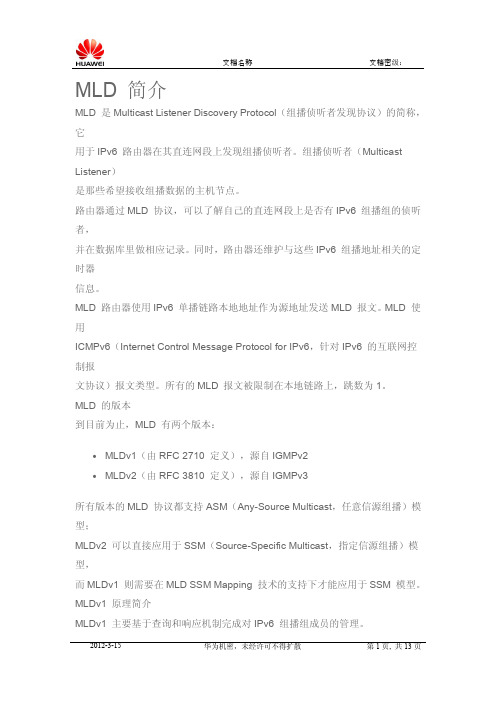
MLD 简介MLD 是Multicast Listener Discovery Protocol(组播侦听者发现协议)的简称,它用于IPv6 路由器在其直连网段上发现组播侦听者。
组播侦听者(Multicast Listener)是那些希望接收组播数据的主机节点。
路由器通过MLD 协议,可以了解自己的直连网段上是否有IPv6 组播组的侦听者,并在数据库里做相应记录。
同时,路由器还维护与这些IPv6 组播地址相关的定时器信息。
MLD 路由器使用IPv6 单播链路本地地址作为源地址发送MLD 报文。
MLD 使用ICMPv6(Internet Control Message Protocol for IPv6,针对IPv6 的互联网控制报文协议)报文类型。
所有的MLD 报文被限制在本地链路上,跳数为1。
MLD 的版本到目前为止,MLD 有两个版本:∙MLDv1(由RFC 2710 定义),源自IGMPv2∙MLDv2(由RFC 3810 定义),源自IGMPv3所有版本的MLD 协议都支持ASM(Any-Source Multicast,任意信源组播)模型;MLDv2 可以直接应用于SSM(Source-Specific Multicast,指定信源组播)模型,而MLDv1 则需要在MLD SSM Mapping 技术的支持下才能应用于SSM 模型。
MLDv1 原理简介MLDv1 主要基于查询和响应机制完成对IPv6 组播组成员的管理。
1. 查询器选举机制当一个网段内有多台IPv6 组播路由器时,由于它们都能从主机那里收到MLD 成员关系报告报文(Multicast Listener Report Message),因此只需要其中一台路由器发送MLD 查询报文(Query Message)就足够了。
这就需要有一个查询器(Querier)的选举机制来确定由哪台路由器作为MLD 查询器,其选举过程如下:(1) 所有MLD 路由器在初始时都认为自己是查询器,并向本地网段内的所有主机和路由器发送MLD 普遍组查询(General Query)报文(目的地址为FF02::1);(2) 本地网段中的其它MLD 路由器在收到该报文后,将报文的源IPv6 地址与自己的接口地址作比较。
rfc2217协议内容

竭诚为您提供优质文档/双击可除rfc2217协议内容篇一:串口服务器410软件设计手册usR-tcp232-410软件设计手册文件版本:V1.0.1目录usR-tcp232-410软件设计手册................................................. ................................................... . (1)1.产品概述................................................. ................................................... ................................................... .. (3)1.1.产品简介.................................................................................................... . (3)1.2.功能特点................................................. ................................................... . (3)1.3.与旧的e45系列的兼容性声明................................................. ................................................... . (4)2.产品功能................................................. ................................................... ................................................... .. (5)2.1.tcpclient模式特性................................................. ................................................... (5)2.2.tcpserver模式特性................................................. ................................................... (7)2.3.udpclient模式特性................................................. ................................................... .. (8)2.4.udpserver模式特性................................................. ................................................... (10)2.5.httpdclient.................................... ................................................... . (11)2.6.Vcom应用模式................................................. ................................................... . (13)2.7.增值功能................................................. ................................................... .. (14)2.7.1.网页转串口功能................................................. ................................................... (14)2.7.2.自定义网页功能................................................. ................................................... (17)2.7.3.modbusRtu转modbustcp.......................................... ................................................... .182.7.4.串口打包机制................................................. ................................................... . (18)2.7.5.流量计算................................................. ................................................... (19)2.7.6.类RFc2217功能................................................. ................................................... (19)3.设置协议................................................. ................................................... ................................................... (21)3.1.网络设置协议................................................. ................................................... (21)3.1.1.设置参数的流程................................................. ................................................... (21)3.1.2.设置指令内容................................................. ................................................... . (21)3.1.3.返回指令内容................................................. ................................................... . (24)3.2.串口设置协议................................................. ................................................... (26)4.免责声明................................................. ................................................... ................................................... (26)5.更新历史................................................. ................................................... ................................................... (26)1.产品概述1.1.产品简介usR-tcp232-410是有人物联网技术有限公司推出的m4系列的串口服务器,是用来将tcp/udp数据包与Rs232/Rs485接口实现数据透明传输的设备。
移动IP技术-第五讲-ICMPv协议和ND协议

1.2.7 路径MTU发现 协议
• 路径MTU发现过程: 源节点向目的节点发送报文,负责转发的 路由器一旦发现包长超过link MTU,向源 报ICMPv6包太大消息并回填link MTU值, 源节点修改发送包长度重新发送。重复直 到包到达目的节点,不再收到ICMPv6包 太大消息为止。
22
1.2.8 路径MTU发 现协议:举例
• ND使用ICMPv6 报告信息:
8bit
8bit
16bit
32bit
– Type=133 路由器请求 – Type=134 路由器通告 – Type=135 邻居请求 – Type=136 邻居通告 – Type=137 重定向
大家好
1
移动IP技术
mobile IP
第五讲 ICMPv6协议和ND协议
2
一 ICMPv6协议 二 ND协议
3
1. ICMPv6协议
一 ICMPv6概述 二 ICMPv6错误报告消息 三 ICMPv6消息
4
ICMPv6协议RFC
• RFC 4443 Internet Control Message Protocol (ICMPv6) for the Internet Protocol Version 6 (IPv6) Specification
• 定义了组播组成员管理消息,RFC2710
37
一 ICMPv6协议 二 ND协议
38
ND协议RFC
• RFC 2461 Neighbor Discovery for IP Version 6 (IPv6)
39
2.ND协议
一 ND概述 二 路由器通告和路由器请求消息 三 邻居请求和邻居通告消息 四 重定向消息
中国电信家庭网关(e8)技术要求V

如有你有帮助,请购买下载,谢谢!保密等级:公开发放中国电信集团公司技术标准Q/CT 2270-2010中国电信家庭网关(e8)技术要求(V3.0)2010-07发布2010-07实施中国电信集团公司发布目录前言..................................................... 错误!未定义书签。
1 范围....................................................... 错误!未定义书签。
2 规范性引用文件............................................. 错误!未定义书签。
3 缩略语..................................................... 错误!未定义书签。
4 设备总体定义............................................... 错误!未定义书签。
4.1 设备在网络中的位置....................................... 错误!未定义书签。
4.2 接口定义................................................. 错误!未定义书签。
4.3 设备形态................................................. 错误!未定义书签。
5 物理接口要求............................................... 错误!未定义书签。
5.1 网络侧接口要求........................................... 错误!未定义书签。
5.2 用户侧接口要求........................................... 错误!未定义书签。
组播侦听发现(MLDv1)协议详解RFC2710

中国地质大学江城学院组播侦听发现(MLDv1)协议详解_RFC2710学部机械与电子信息学部班级11计网本1学号2320110102姓名王青指导教师辛玲2013年11月16 日目录Table of Contents1 MLDv1简介......................................................................................................... . (3)2 消息格式 (4)2.1 代码(Code) (4)2.2 校验和(Checksum)............................................................................... (4)2.3 最大响应延迟(Maximum Response Delay)......................................... . (5)2.4 保留(Reserved) (5)2.5 组播地址(Multicast Address).................................................................... .. (5)2.6 其他区域(Other fields).............................................................................. . (5)3 协议描述 (5)4 节点状态转换图.................................................................... (7)5 路由器状态转换图............................................................. ................................ . (9)6 定时器及其缺省值列表.......................................................................................... .. (13)6.1 健壮性变量(Robustness Variable)............................................................. .. (13)6.2 查询间隔(Query Interval).......................................... .. (13)6.3 查询响应间隔(Query Response Interval).................. .............................. . (13)6.4 组播侦听者间隔(Multicast Listener Interval).............................. .............. (14)6.5 其他查询器存在间隔(Other Querier Present Interval)................................ . (14)6.6 启动查询间隔(Startup Query Interval)........................................................ . (14)6.7 启动查询次数(Startup Query Count) (14)6.8 最后侦听者查询间隔(Last Listener Query Interval)............................ ........ (14)6.9 最后侦听者查询次数(Last Listener Query Count)......................... (14)6.10 主动报告间隔(Unsolicited Report Interval) (14)7 消息目的地址 (14)文档标题关键词Key words:IPv6、MLD、IGMPv2本文档介绍了IPv6路由器所使用的一种协议,用以发现在其直连网络上的组播侦听者(即希望接收组播数据的节点)的存在,并且能明确发现这些邻居节点所感兴趣的组播地址。
IPv6 基础知识简介

4、ICMPv6 协议
ICMPv6 是IPv6的基础协议之一 邻居发现、PathMTU发现机制均是基于ICMPv6协议报文 实现的 ICMPv6由ICMPv4(RFC792)而来,做了一部分的改动, 但报文基本格式和用法是一样的 ICMPv6的Next Header值为58 ICMPv6的RFC编号2463
Page 4
1、IPv6的产生背景
Page 5
IPv6的技术特点
128位的地址长度 新的地址分类和地址分配方案 简化、高效的报文结构 内置的安全特性 用组播代替广播 更好的支持移动性 自动地址配置方便IPv6网络的部署 提供多种过渡机制
Page 6
目录
1. IPv6 产生的背景 2. IPv6 地址 3. IPv6 报文结构 4. ICMPv6 协议 5. IPv6 邻居发现协议 6. IPv6 Path MTU 7. 无状态的地址分配 8. 有状态的地址分配:DHCPV6 9. 用户接入认证:PPPoEv6 10. DNS6
同一个地址不同表示法的例子
2001:0410:0000:0001:0000:0000:0000:45FF/64 2001:410:0:1:0:0:0:45FF/64 2001:410:0:1::45FF/64
Page 8
2、IPv6 地址—分类
单播地址(Unicast ): 标识一个接口,目的为单播地址的报文会被送到被标识的接口。
Flags 永久标志 0RP0:永久多播地址 0RP1:临时多播地址
Scope 应用范围 0001:接口本地范围,单个接口范围有效,仅用于多播的Loopback操作 0010:链路本地范围 0100:管理本地范围,管理员配置的 0101:站点本地范围 1000:组织本地范围,属于同一个组织的多个站点范围 1110:全局范围 其他的为保留或未定义,可由管理员来定义附加的多播范围
ipv6测试解决方案

所以确保双栈路由器可以可以完成以下功能是至关重要的:
©2006 Ixia. All rights reserved.
IPv6 一致性测试
根据IPv6标准的每行描述准确的制定自动化测试案例库 – IPv6 一致 性测试套件 彻底检查每个RFC定义的功能 实施一致性测试保证设备的互连互通 在产品设计阶段就发现问题,而不是到客户现场解决问题!! 为回归测试提供基准 帮助运营商和ISP诊断互操作问题 测试工具- IxANVL
©2006 Ixia. All rights reserved.
IPv6测试平台及典型配置
IXIA公司是全球领先的最大的IP测试公司之一
– – 连续29个季度赢利 销售额在1998至2005年间增长超过2200%,年销售额超过1.5亿美元
一致性工具:IxANVL IPv6双栈路由器功能及性能工具:IxNetwork、IxScripteMate IPv6 BRAS功能及性能工具:IxAccess、IxNetwork IPv6 VPN网关功能及性能工具:IxVPN IPv6 应用层功能及性能工具:IxLoad、IxChariot
面向IPv6 测试解决方案
Jason Han Senior System Engineer, Ixia jhan@
议程
IPv6 测试的重要性,必要性 IPv4 到 IPv6 演变策略 主要测试方向 IPv6 一致性测试 IPv4/IPv6 功能和性能测试 IPv6/IPv4 隧道测试 路由性能和扩展性测试 组播性能和扩展性测试
输入
指定负载 报文长 地址范围
结果
吞吐量, 时延, 丢包 率
©2006 Ixia. All rights reserved.
路由性能和扩展性
ipv6测试解决方案

©2006 Ixia. All rights reserved.
总结
双栈路由器带来新功能:
– – – 建立维护隧道 地址和协议转换 完成新的路由协议
一致性测试对于不同厂家的设计产品是至关重要的 验证新的双栈路由器的转发功能是否正确和性能测试也是必须 的 评估路由器在新的路由协议下的性能和扩展性也是十分重要的 在应用层的测试也是必须的,它可以改善最终用户的体验
应用程序的有效吞吐量及响应时间
IXIA公司IPv6测试平台及典型配置 总结
©2006 Ixia. All rights reserved.
IPv6 测试的重要性
IPv6 带来的技术革新
– 与IPv4相比,IPv6在寻址、标记、QoS、多媒体、安全性、移动性和高级 管理等方面有突出增强,是下一代的承载技术 – IPv6不仅涉及三层承载,同时涉及封装、路由、加密、隧道、应用等多个 层面,是一个全方位的革新 – 与此相适应的测试需求,也在二到七层全面展开 – 由IPv6引发的新规范: – RFC 2460, RFC 2461,RFC 2462,RFC 1981,RFC 2675, RFC 2374,RFC 3056, RFC 3122, RFC 2893, RFC 2473, RFC 3056RFC 2766, RFC 2765, RFC 2090, RFC 2740RFC 2545 – 成功的IPv6测试意味着成功的产品研发及生产,成功的网络及业务部署。
©2006 Ixia. All rights reserved.
转发功能和性能
目标
功能
输入
报文头、内容、报 文长 指定负载 报文头、内容、报 文长,IPv6/IPv4 混 合比例
结果
报文头、内容完整 性检查,丢包率
listener 协议
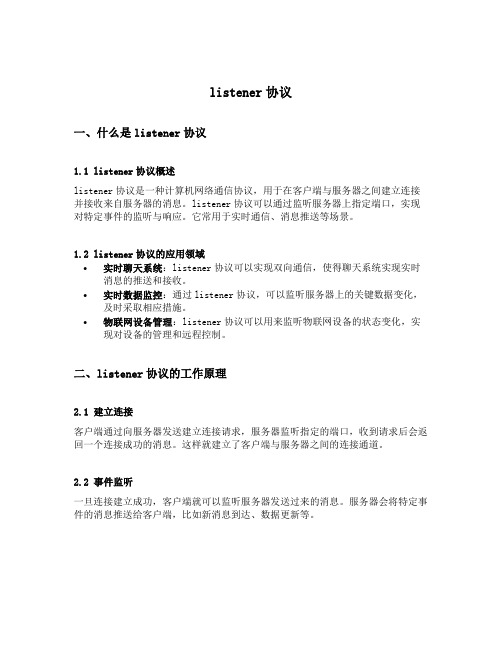
listener协议一、什么是listener协议1.1 listener协议概述listener协议是一种计算机网络通信协议,用于在客户端与服务器之间建立连接并接收来自服务器的消息。
listener协议可以通过监听服务器上指定端口,实现对特定事件的监听与响应。
它常用于实时通信、消息推送等场景。
1.2 listener协议的应用领域•实时聊天系统:listener协议可以实现双向通信,使得聊天系统实现实时消息的推送和接收。
•实时数据监控:通过listener协议,可以监听服务器上的关键数据变化,及时采取相应措施。
•物联网设备管理:listener协议可以用来监听物联网设备的状态变化,实现对设备的管理和远程控制。
二、listener协议的工作原理2.1 建立连接客户端通过向服务器发送建立连接请求,服务器监听指定的端口,收到请求后会返回一个连接成功的消息。
这样就建立了客户端与服务器之间的连接通道。
2.2 事件监听一旦连接建立成功,客户端就可以监听服务器发送过来的消息。
服务器会将特定事件的消息推送给客户端,比如新消息到达、数据更新等。
2.3 消息处理客户端收到消息后,可以根据消息内容进行相应的处理。
例如,在聊天系统中,客户端可以将新消息显示在聊天界面上;在实时数据监控系统中,客户端可以根据数据内容来做出相应的图表展示或预警。
2.4 断开连接当不再需要监听服务器的消息时,客户端可以主动断开连接,也可以等待服务器端断开连接。
三、listener协议的优势与特点3.1 实时性listener协议可实现实时消息推送,无需客户端主动轮询服务器,大大提高了通信效率。
3.2 节省带宽相比于轮询,listener协议只在有消息时才进行数据传输,减少了无效的数据传输,节省了带宽资源。
3.3 简化开发使用listener协议,开发者只需关注消息的接收和处理,无需过多关注网络通信的细节,大大简化了开发流程。
四、常见的listener协议实现4.1 WebSocketWebSocket是一种基于TCP的通信协议,实现了客户端与服务器之间的全双工通信。
组播侦听发现(MLDv1)协议详解RFC2710

中国地质大学江城学院组播侦听发现(MLDv1)协议详解_RFC2710学部机械与电子信息学部班级11计网本1学号2320110102姓名王青指导教师辛玲2013年11月16 日目录Table of Contents1 MLDv1简介......................................................................................................... . (3)2 消息格式 (4)2.1 代码(Code) (4)2.2 校验和(Checksum)............................................................................... (4)2.3 最大响应延迟(Maximum Response Delay)......................................... . (5)2.4 保留(Reserved) (5)2.5 组播地址(Multicast Address).................................................................... .. (5)2.6 其他区域(Other fields).............................................................................. . (5)3 协议描述 (5)4 节点状态转换图.................................................................... (7)5 路由器状态转换图............................................................. ................................ . (9)6 定时器及其缺省值列表.......................................................................................... .. (13)6.1 健壮性变量(Robustness Variable)............................................................. .. (13)6.2 查询间隔(Query Interval).......................................... .. (13)6.3 查询响应间隔(Query Response Interval).................. .............................. . (13)6.4 组播侦听者间隔(Multicast Listener Interval).............................. .............. (14)6.5 其他查询器存在间隔(Other Querier Present Interval)................................ . (14)6.6 启动查询间隔(Startup Query Interval)........................................................ . (14)6.7 启动查询次数(Startup Query Count) (14)6.8 最后侦听者查询间隔(Last Listener Query Interval)............................ ........ (14)6.9 最后侦听者查询次数(Last Listener Query Count)......................... (14)6.10 主动报告间隔(Unsolicited Report Interval) (14)7 消息目的地址 (14)文档标题关键词Key words:IPv6、MLD、IGMPv2本文档介绍了IPv6路由器所使用的一种协议,用以发现在其直连网络上的组播侦听者(即希望接收组播数据的节点)的存在,并且能明确发现这些邻居节点所感兴趣的组播地址。
FortiSwitch
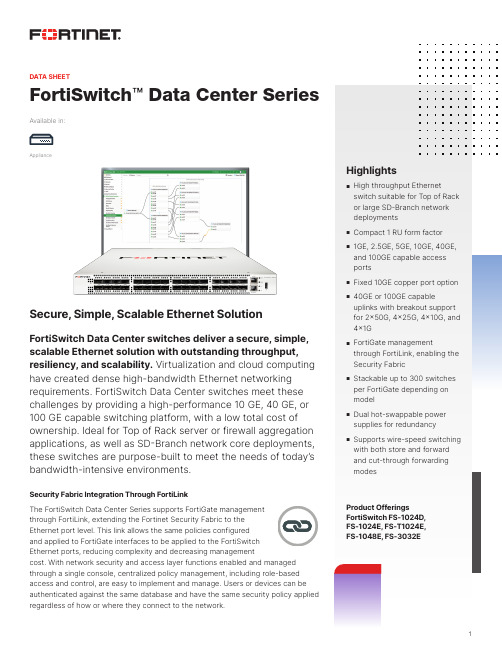
1FortiSwitch ™ Data Center SeriesSecure, Simple, Scalable Ethernet SolutionFortiSwitch Data Center switches deliver a secure, simple,scalable Ethernet solution with outstanding throughput, resiliency, and scalability. Virtualization and cloud computing have created dense high-bandwidth Ethernet networking requirements. FortiSwitch Data Center switches meet these challenges by providing a high-performance 10 GE, 40 GE, or 100 GE capable switching platform, with a low total cost of ownership. Ideal for Top of Rack server or firewall aggregation applications, as well as SD-Branch network core deployments, these switches are purpose-built to meet the needs of today’s bandwidth-intensive environments.Highlightsn High throughput Ethernetswitch suitable for Top of Rack or large SD-Branch network deploymentsn Compact 1 RU form factor n 1GE, 2.5GE, 5GE, 10GE, 40GE,and 100GE capable access portsn Fixed 10GE copper port option n 40GE or 100GE capableuplinks with breakout support for 2x50G, 4x25G, 4x10G, and 4x1Gn FortiGate managementthrough FortiLink, enabling the Security Fabricn Stackable up to 300 switchesper FortiGate depending on modeln Dual hot-swappable powersupplies for redundancyn Supports wire-speed switchingwith both store and forward and cut-through forwarding modesProduct OfferingsFortiSwitch FS-1024D, FS-1024E, FS-T1024E, FS-1048E, FS-3032EDATA SHEETAvailable in:ApplianceSecurity Fabric Integration Through FortiLinkThe FortiSwitch Data Center Series supports FortiGate management through FortiLink, extending the Fortinet Security Fabric to the Ethernet port level. This link allows the same policies configured and applied to FortiGate interfaces to be applied to the FortiSwitch Ethernet ports, reducing complexity and decreasing managementcost. With network security and access layer functions enabled and managed through a single console, centralized policy management, including role-based access and control, are easy to implement and manage. Users or devices can be authenticated against the same database and have the same security policy applied regardless of how or where they connect to the network.DATA SHEET | FortiSwitch™ Data Center Series2DEPLOYMENTNon FortiGateFortiSwitch can be managed without a FortiGate in a traditional stand-alone fashion with a native GUI and CLI interface. FortiSwitch Manager offers stacking and management atscale with a network design similar to a FortiGate-managed deployment. Thisdesign supports up to 2500 FortiSwitches but offers no traffic inspection or Security Fabric integration. Lastly, RESTful API’s offer additional configuration andmanagement tools.FortiGateFortiGate management is accomplished through FortiLink, an innovative proprietary management protocol that allows our FortiGate security appliance to seamlessly manage any FortiSwitch. FortiLink enables the FortiSwitch to become a logical extension of the FortiGate, integrating it directly into the Fortinet Security Fabric.Deployment OverviewFortiSwitch is commonly managed and deployed through our FortiGate with FortiLink but can also be deployed and managed innon-FortiGate environments.3DATA SHEET | FortiSwitch™ Data Center SeriesHARDWAREFortiSwitch 1024D — backFortiSwitch 1024D — frontFortiSwitch 1024E — frontFortiSwitch 1024E — backFortiSwitch T1024E — frontFortiSwitch T1024E — backDATA SHEET | FortiSwitch™ Data Center Series4HARDWAREFortiSwitch 1048E — frontFortiSwitch 1048E — backFortiSwitch 3032E — frontFortiSwitch 3032E — backDATA SHEET | FortiSwitch™ Data Center Series FEATURESLAG Support for FortiLink Connection YesSupport FortiLink FortiGate in HA Cluster Yes5DATA SHEET | FortiSwitch™ Data Center Series6FEATURESLayer 2Auto-Negotiation for Port Speed and Duplex Yes Yes Yes Yes Auto Topology Yes Yes Yes Yes Edge Port / Port Fast Yes Yes Yes Yes IEEE 802.1ad QnQYes Yes Yes Yes IEEE 802.1AX Link Aggregation Yes Yes Yes Yes IEEE 802.1D MAC Bridging/STP Yes Yes Yes Yes IEEE 802.1Q VLAN TaggingYes Yes Yes Yes IEEE 802.1Qbb Priority-based Flow ControlYes Yes Yes Yes IEEE 802.1s Multiple Spanning Tree Protocol (MSTP)Yes Yes Yes Yes IEEE 802.1w Rapid Spanning Tree Protocol (RSTP)Yes Yes Yes Yes IEEE 802.3 CSMA/CD Access Method and Physical Layer SpecificationsYes Yes Yes Yes IEEE 802.3ab 1000Base-TYes Yes Yes Yes IEEE 802.3ad Link Aggregation with LACP Yes Yes Yes Yes IEEE 802.3ae 10 Gigabit EthernetYes Yes Yes Yes IEEE 802.3ba, 802.3bj, 802.3bm 40 and 100 Gigabit EthernetNo Yes Yes Yes IEEE 802.3bz Multi Gigabit Ethernet No Yes No No IEEE 802.3u 100Base-TXYes No / Yes No Yes IEEE 802.3x Flow Control and Back-pressure Yes Yes Yes Yes IEEE 802.3z 1000Base-SX/LX Yes Yes Yes Yes Ingress Pause Metering Yes Yes Yes No Jumbo Frames Yes Yes Yes Yes LAG Min/Max Bundle Yes Yes Yes Yes Loop GuardYes Yes Yes Yes MAC, IP, Ethertype-based VLANs Yes Yes Yes Yes PHY Forward Error Correction No Yes Yes Yes Private VLANYes Yes Yes Yes Rapid PVST InteroperationYes Yes Yes Yes Spanning Tree Instances (MSTP/CST)32/132/132/132/1Split Port No No Yes Yes Storm Control Yes Yes Yes Yes STP BPDU Guard Yes Yes Yes Yes STP Root GuardYes Yes Yes Yes Unicast/Multicast traffic balance over trunking port(dst-ip, dst-mac, src-dst-ip, src-dst-mac, src-ip, src-mac)Yes Yes Yes Yes Virtual-Wire Yes Yes Yes Yes VLAN MappingYes Yes Yes Yes Dynamically shared packet buffersYesYesYesYesDATA SHEET | FortiSwitch™ Data Center Series FEATURESACL Yes, 2K entries Yes, 3K Yes, 4K entries Yes, 1K entriesACL Multiple Ingress Yes Yes Yes YesACL Multistage Yes Yes Yes YesACL Schedule Yes Yes Yes YesAdmin Authentication Via RFC 2865 RADIUS Yes Yes Yes YesAssign VLANs via Radius attributes (RFC 4675)Yes Yes Yes YesDHCP-Snooping Yes Yes Yes YesDynamic ARP Inspection Yes Yes Yes YesFIPS 140-2 (level 2) support No Yes Yes YesFlow Export (NetFlow and IPFIX)Yes Yes Yes YesIEEE 802.1ab Link Layer Discovery Protocol (LLDP)Yes Yes Yes YesIEEE 802.1ab LLDP-MED Yes Yes Yes YesIEEE 802.1X Authentication MAC-based Yes Yes Yes YesIEEE 802.1X Authentication Port-based Yes Yes Yes YesIEEE 802.1X Dynamic VLAN Assignment Yes Yes Yes YesIEEE 802.1X EAP Pass-Through Yes Yes Yes YesIEEE 802.1X Guest and Fallback VLAN Yes Yes Yes YesIEEE 802.1X MAC Access Bypass (MAB)Yes Yes Yes YesIEEE 802.1X Open Auth Yes Yes Yes YesIP Source Guard Yes Yes Yes YesIPv6 RA Guard Yes Yes Yes YesLLDP-MED ELIN support Yes Yes Yes YesMAC-IP Binding Yes Yes Yes YesPort Mirroring Yes Yes Yes YesRADIUS Accounting Yes Yes Yes YesRADIUS CoA Yes Yes Yes YessFlow Yes Yes Yes YesSticky MAC Yes Yes Yes YesWake on LAN Yes Yes Yes Yes* Requires ‘A dvanced Features’ License7DATA SHEET | FortiSwitch™ Data Center SeriesFEATURESIEEE 1588 PTP (Transparent Clock)No Yes Yes Yes89DATA SHEET | FortiSwitch™ Data Center SeriesRFC COMPLIANCERFC and MIB Support*BFDRFC 5880: Bidirectional Forwarding Detection (BFD)RFC 5881: Bidirectional Forwarding Detection (BFD) for IPv4 and IPv6 (Single Hop)RFC 5882: Generic Application of Bidirectional Forwarding Detection (BFD)BGPRFC 1771: A Border Gateway Protocol 4 (BGP-4)RFC 1965: Autonomous System Confederations for BGP RFC 1997: BGP Communities AttributeRFC 2545: Use of BGP-4 Multiprotocol Extensions for IPv6 Inter-Domain Routing RFC 2796: BGP Route Reflection - An Alternative to Full Mesh IBGP RFC 2842: Capabilities Advertisement with BGP-4RFC 2858: Multiprotocol Extensions for BGP-4RFC 4271: BGP-4RFC 6286: Autonomous-System-Wide Unique BGP Identifier for BGP-4RFC 6608: Subcodes for BGP Finite State Machine ErrorRFC 6793: BGP Support for Four-Octet Autonomous System (AS) Number Space RFC 7606: Revised Error Handling for BGP UPDATE Messages RFC 7607: Codification of AS 0 ProcessingRFC 7705: Autonomous System Migration Mechanisms and Their Effects on the BGP AS_PATH AttributeRFC 8212: Default External BGP (EBGP) Route Propagation Behavior without Policies RFC 8654: Extended Message Support for BGP DHCPRFC 2131: Dynamic Host Configuration Protocol RFC 3046: DHCP Relay Agent Information OptionRFC 7513: Source Address Validation Improvement (SAVI) Solution for DHCP IP/IPv4RFC 2697: A Single Rate Three Color MarkerRFC 3168: The Addition of Explicit Congestion Notification (ECN) to IP RFC 5227: IPv4 Address Conflict DetectionRFC 5517: Cisco Systems' Private VLANs: Scalable Security in a Multi-Client EnvironmentRFC 7039: Source Address Validation Improvement (SAVI) Framework* RFC and MIB supported by FortiSwitch Operating System. Check feature matrix in administration guide for model specific support.RFC and MIB Support*IP MulticastRFC 2362: Protocol Independent Multicast-Sparse Mode (PIM-SM): Protocol SpecificationRFC 2710: Multicast Listener Discovery (MLD) for IPv6 (MLDv1)RFC 4541: Considerations for Internet Group Management Protocol (IGMP) and Multicast Listener Discovery (MLD) Snooping SwitchesRFC 4605: Internet Group Management Protocol (IGMP)/Multicast Listener Discovery (MLD)-Based Multicast Forwarding (“IGMP/MLD Proxying”)RFC 4607: Source-Specific Multicast for IP IPv6RFC 2464: Transmission of IPv6 Packets over Ethernet Networks: Transmission of IPv6 Packets over Ethernet NetworksRFC 2474: Definition of the Differentiated Services Field (DS Field) in the and IPv6 Headers (DSCP)RFC 2893: Transition Mechanisms for IPv6 Hosts and Routers RFC 4213: Basic Transition Mechanisms for IPv6 Hosts and Router RFC 4291: IP Version 6 Addressing ArchitectureRFC 4443: Internet Control Message Protocol (ICMPv6) for the Internet Protocol Version 6 (IPv6) SpecificationRFC 4861: Neighbor Discovery for IP version 6 (IPv6)RFC 4862: IPv6 Stateless Address Auto configuration RFC 5095: Deprecation of Type 0 Routing Headers in IPv6RFC 6724: Default Address Selection for Internet Protocol version 6 (IPv6)RFC 7113: IPv6 RA GuardRFC 8200: Internet Protocol, Version 6 (IPv6) Specification RFC 8201: Path MTU Discovery for IP version 6IS-ISRFC 1195: Use of OSI IS-IS for Routing in TCP/IP and Dual Environments RFC 5308: Routing IPv6 with IS-IS MIBRFC 1213: MIB II parts that apply to FortiSwitch 100 units RFC 1354: IP Forwarding Table MIB RFC 1493: Bridge MIB RFC 1573: SNMP MIB IIRFC 1643: Ethernet-like Interface MIBDATA SHEET | FortiSwitch™ Data Center Series10RFC COMPLIANCERFC and MIB Support*MIBRFC 1724: RIPv2-MIBRFC 1850: OSPF Version 2 Management Information Base RFC 2233: The Interfaces Group MIB using SMIv2RFC 2618: Radius-Auth-Client-MIB RFC 2620: Radius-Acc-Client-MIBRFC 2674: Definitions of Managed Objects for Bridges with Traffic Classes, Multicast Filtering and Virtual LAN extensionsRFC 2787: Definitions of Managed Objects for the Virtual Router Redundancy Protocol RFC 2819: Remote Network Monitoring Management Information Base RFC 2863: The Interfaces Group MIB RFC 2932: IPv4 Multicast Routing MIBRFC 2934: Protocol Independent Multicast MIB for IPv4RFC 3289: Management Information Base for the Differentiated Services Architecture RFC 3433: Entity Sensor Management Information Base RFC 3621: Power Ethernet MIB RFC 6933: Entity MIB (Version 4)OSPFRFC 1583: OSPF version 2RFC 1765: OSPF Database Overflow RFC 2328: OSPF version 2RFC 2370: The OSPF Opaque LSA Option RFC 2740: OSPF for IPv6RFC 3101: The OSPF Not-So-Stubby Area (NSSA) Option RFC 3137: OSPF Stub Router Advertisement RFC 3623: OSPF Graceful Restart RFC 5340: OSPF for IPv6 (OSPFv3)RFC 5709: OSPFv2 HMAC-SHA Cryptographic Authentication RFC 6549: OSPFv2 Multi-Instance ExtensionsRFC 6845: OSPF Hybrid Broadcast and Point-to-Multipoint Interface Type RFC 6860: Hiding Transit-Only Networks in OSPFRFC 7474: Security Extension for OSPFv2 When Using Manual Key Management RFC 7503: OSPF for IPv6RFC 8042: CCITT Draft Recommendation T.4RFC 8362: OSPFv3 Link State Advertisement (LSA) Extensibility* RFC and MIB supported by FortiSwitch Operating System. Check feature matrix in administration guide for model specific support.RFC and MIB Support*OTHERRFC 2030: SNTPRFC 3176: InMon Corporation's sFlow: A Method for Monitoring Traffic in Switched and Routed Networks RFC 3768: VRRPRFC 3954: Cisco Systems NetFlow Services Export Version 9RFC 5101: Specification of the IP Flow Information Export (IPFIX) Protocol for the Exchange of Flow Information RFC 5798: VRRPv3 (IPv4 and IPv6)RADIUSRFC 2865: Admin Authentication Using RADIUS RFC 2866: RADIUS AccountingRFC 4675: RADIUS Attributes for Virtual LAN and Priority SupportRFC 5176: Dynamic Authorization Extensions to Remote Authentication Dial In User Service (RADIUS)RIPRFC 1058: Routing Information Protocol RFC 2080: RIPng for IPv6RFC 2082: RIP-2 MD5 Authentication RFC 2453: RIPv2RFC 4822: RIPv2 Cryptographic Authentication SNMPRFC 1157: SNMPv1/v2cRFC 2571: Architecture for Describing SNMPRFC 2572: SNMP Message Processing and Dispatching RFC 2573: SNMP ApplicationsRFC 2576: Coexistence between SNMP versions VXLANRFC 7348: Virtual eXtensible Local Area Network (VXLAN)11DATA SHEET | FortiSwitch™ Data Center SeriesFORTISWITCH 1024EFORTISWITCH T1024E* Fortinet Warranty Policy: /doc/legal/EULA.pdfSPECIFICATIONSDATA SHEET | FortiSwitch™ Data Center Series12* Full line rate with minimum packet size of 427 bytes on FS-1048E and 250bytes on FS-3032E ** Fortinet Warranty Policy:/doc/legal/EULA.pdfSPECIFICATIONSDATA SHEET | FortiSwitch™ Data Center Series ORDER INFORMATIONFortiSwitch Advanced Features License FS-SW-LIC-1000SW License for FS-1000 Series Switches to activate Advanced Features.FS-SW-LIC-3000SW License for FS-3000 Series Switches to activate Advanced Features.AC Power Supply FS-PSU-460Spare AC power supply for FS-1048E/1024D.FS-PSU-800Spare AC power supply for FS-3032E.* When managing a FortiSwitch with a FortiGate via FortiGate Cloud, no additional license is necessary.For details of Transceiver modules, see the Fortinet Transceivers datasheet. Copyright © 2022 Fortinet, Inc. All rights reserved. Fortinet, FortiGate, FortiCare and FortiGuard, and certain other marks are registered trademarks of Fortinet, Inc., and other Fortinet names herein may also be registered and/or common law trademarks of Fortinet. All other product or company names may be trademarks of their respective owners. Performance and other metrics contained herein were attained in internal lab tests under ideal conditions, and actual performance and other results may vary. Network variables, different network environments and other conditions may affect performance results. Nothing herein represents any binding commitment by Fortinet, and Fortinet disclaims all warranties, whether express or implied, except to the extent Fortinet enters a binding written contract, signed by Fortinet’s General Counsel, with a purchaser that expressly warrants that the identified product will perform according to certain expressly-identified performance metrics and, in such event, only the specific performance metrics expressly identified in such binding written contract shall be binding on Fortinet. For absolute clarity, any such warranty will be limited to performance in the same ideal conditions as in Fortinet’s internal lab tests. Fortinet disclaims in full any covenants, representations, and guarantees pursuant hereto, whether express or implied. Fortinet reserves the right to change, modify, transfer, or otherwise revise this publication without notice, and the most current version of the publication shall be applicable.Fortinet is committed to driving progress and sustainability for all through cybersecurity, with respect for human rights and ethical business practices, making possible a digital world you can always trust. You represent and warrant to Fortinet that you will not use Fortinet’s products and services to engage in, or support in any way, violations or abuses of human rights, including those involving illegal censorship, surveillance, detention, or excessive use of force. Users of Fortinet products are required to comply with the Fortinet EULA (https:///content/dam/fortinet/assets/legal/EULA.pdf) and report any suspected violations of the EULA via the procedures outlined in the Fortinet Whistleblower Policy (https:///domain/media/en/gui/19775/Whistleblower_Policy.pdf).FS-DC-DAT-R31-20221109。
服务器运维风险评估措施

服务器运维风险评估措施服务器运维风险评估措施(ISO27001-2013)一、服务器风险预估1.服务器被攻击1.1.拒绝服务攻击拒绝服务攻击的方式很多,主要常用的攻击手段有SYN Flood、UPD洪水、IP 欺骗攻击、CC攻击。
防范DDOS攻击首先要能够检测到,并且及时做出响应,才可以防范。
SYN Flood通过TCP三次握手的原理,服务器如果出现第三次握手包迟迟收不到,将会占用服务器的内存资源,攻击者在较短时间内伪造大量不存在的源IP 地址数据包进行攻击,将会耗尽服务器的内存资源,最后无法提供正常服务。
根据SYN Flood的攻击方式,可见动态的根据攻击流量进行设置TCP第三次握手的超时时间是降低攻击效果的主要方法。
1.2.入侵检测遭受黑客入侵不可怕,可怕的是被入侵还不知道,这就需要部署一台入侵检测设备,可以使用开源的Snort进行部署,但是IDS的误报率会很高,而使用OSSIM 的关联分析功能就可以减少很多误报。
1.3.防火墙防护将服务器放置在防火墙的DMZ区域,通过对防火墙进行配置可以避免外网对服务器进行端口扫描,从而提高服务器的安全。
放置在DMZ区有另一个好处就是可以保护内部网络。
2.内部环境安全2.1.防止ARP欺骗攻击通过在交换机的接口进行MAC绑定,实现终端设备的接入控制,这样就可以防止恶意用户的接入。
终端电脑绑定网关的MAC地址,以防攻击者欺骗网关。
对ARP数据包进行检测,防止ARP洪泛攻击。
2.2.可信任主机接入在交换机端口下,对IP地址与MAC地址进行绑定,可以限制特定用户对网络进行访问,其余的用户无法接入网络。
2.3.DHCP欺骗攻击在接入层网络伪造一台DHCP服务器,将所有的网络流量指向黑客创建的伪造网关,所有到伪造网关的流量都会被分析,并且通过伪造DNS,把国内一些大站点的域名指向钓鱼网站,或者放入最新的溢出漏洞夹杂在页面中,造成的危害会很大。
通过在交换机上配置DHCP可行端口进行防范DHCP的欺骗攻击。
- 1、下载文档前请自行甄别文档内容的完整性,平台不提供额外的编辑、内容补充、找答案等附加服务。
- 2、"仅部分预览"的文档,不可在线预览部分如存在完整性等问题,可反馈申请退款(可完整预览的文档不适用该条件!)。
- 3、如文档侵犯您的权益,请联系客服反馈,我们会尽快为您处理(人工客服工作时间:9:00-18:30)。
RFC 2710 Multicast Listener Discovery for IPv6 October 1999
provided to whichever multicast routing protocol is being used by the
Status of this Memo
This document specifies an Internet standards track protocol for the
Internet community, and requests discussion and suggestions for
The purpose of Multicast Listener Discovery (MLD) is to enable each
IPv6 router to discover the presence of multicast listeners (that is,
nodes wishing to receive multicast packets) on its directly attached
+ Multicast Address +
| |
+ +
Network Working Group S. Deering
Request for Comments: 2710 Cisco Systems
discover the presence of multicast listeners (that is, nodes wishing
to receive multicast packets) on its directly attached links, and to
discover specifically which multicast addresses are of interest to
| |
+ +
| |
those neighboring nodes. This protocol is referred to as Multicast
Listener Discovery or MLD. MLD is derived from version 2 of IPv4's
Internet Group Management Protocol, IGMPv2. One important difference
multicast addresses in which the routers themselves have no
interest.)
MLD messages have the following format:
0 1 2 3
Source Address, an IPv6 Hop Limit of 1, and an IPv6 Router Alert
option [RTR-ALERT] in a Hop-by-Hop Options header. (The Router Alert
option is necessary to cause routers to examine MLD messages sent to
"SHOULD", "SHOULD NOT", "RECOMMENDED", "MAY", and "OPTIONAL" in this
document are to be interpreted as described in RFC 2119 [KEYWORDS].
2. Introduction
| |
+-+-+-+-+-+-+-+-+-+-+-+-+-+-+-+-+-+-+-+-+-+-+-+-+-+-+-+-+-+-+-+-+
Deering, et al. Standards Track [Page 2]
+-+-+-+-+-+-+-+-+-+-+-+-+-+-+-+-+-+-+-+-+-+-+-+-+-+-+-+-+-+-+-+-+
| Maximum Response Delay | Reserved |
+-+-+-+-+-+-+-+-+-+-+-+-+-+-+-+-+-+-+-+-+-+-+-+-+-+-+-+-+-+-+-+-+
0 1 2 3 4 5 6 7 8 9 0 1 2 3 4 5 6 7 8 9 0 1 2 3 4 5 6 7 8 9 0 1
+-+-+-+-+-+-+-+-+-+-+-+-+-+-+-+-+-+-+-+-+-+-+-+-+-+-+-+-+-+-+-+-+
| Type | Code | Checksum |
RFC 2710 Multicast Listener Discovery for IPv6 October 1999
to note is that MLD uses ICMPv6 (IP Protocol 58) message types,
rather than IGMP (IP Protocol 2) message types. Biblioteka 1. Definitions
The key words "MUST", "MUST NOT", "REQUIRED", "SHALL", "SHALL NOT",
IBM
October 1999
Multicast Listener Discovery (MLD) for IPv6
links, and to discover specifically which multicast addresses are of
interest to those neighboring nodes. This information is then
Deering, et al. Standards Track [Page 1]
Category: Standards Track W. Fenner
AT&T Research
B. Haberman
improvements. Please refer to the current edition of the "Internet
Official Protocol Standards" (STD 1) for the standardization state
and status of this protocol. Distribution of this memo is unlimited.
Copyright Notice
Copyright (C) The Internet Society (1999). All Rights Reserved.
Abstract
This document specifies the protocol used by an IPv6 router to
multicast listeners and for routers. For those multicast addresses
to which a router itself is listening, the router performs both parts
of the protocol, including responding to its own messages.
router, in order to ensure that multicast packets are delivered to
all links where there are interested receivers.
MLD is an asymmetric protocol, specifying different behaviors for
subset of the set of ICMPv6 messages, and MLD messages are identified
in IPv6 packets by a preceding Next Header value of 58. All MLD
messages described in this document are sent with a link-local IPv6
on all interfaces from which an application or upper-layer protocol
